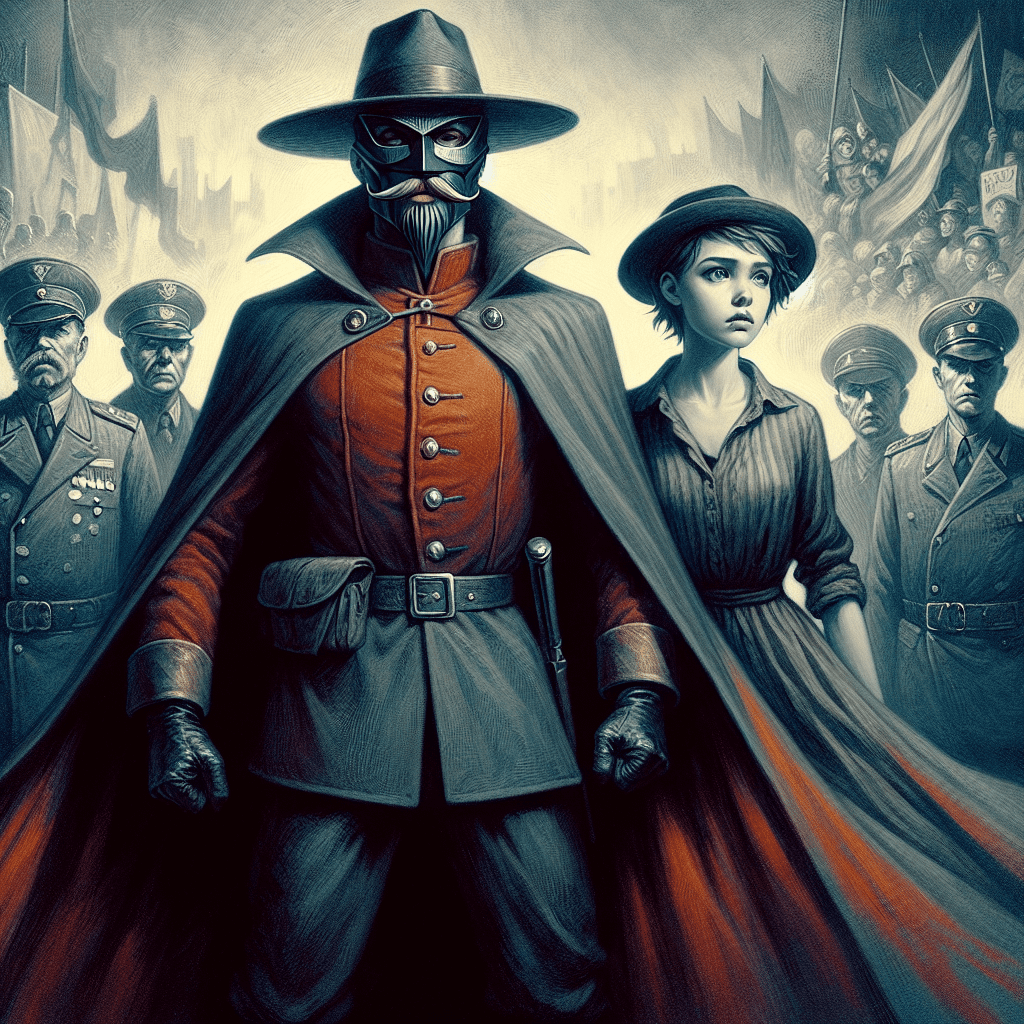-
Table of Contents
- V for Vendetta: Casting Choices and Their Impact
- Exploring the Themes of Anarchy and Freedom in V for Vendetta
- Character Analysis: V and His Symbolism
- Evey Hammond: The Journey from Innocence to Empowerment
- The Role of Government and Oppression in V for Vendetta
- The Significance of the Guy Fawkes Mask in Modern Culture
- Supporting Characters: Their Influence on the Narrative and Themes
- Q&A
“Unmasking Revolution: A Deep Dive into V for Vendetta’s Casting, Themes, and Characters.”
“V for Vendetta” is a dystopian film directed by James McTeigue, based on the graphic novel by Alan Moore and David Lloyd. The casting of the film plays a crucial role in bringing its complex characters to life, with Hugo Weaving portraying the enigmatic anti-hero V and Natalie Portman as Evey Hammond, a young woman drawn into V’s revolutionary plans. The film explores themes of totalitarianism, freedom, and the power of individual action against oppression. It delves into the moral ambiguities of vengeance and justice, as well as the impact of fear on society. The characters, each with their own motivations and backgrounds, contribute to a rich narrative that challenges viewers to consider the cost of freedom and the nature of resistance.
V for Vendetta: Casting Choices and Their Impact
The film adaptation of “V for Vendetta,” directed by James McTeigue and released in 2005, is a striking representation of Alan Moore and David Lloyd’s graphic novel. The casting choices made for this film played a pivotal role in shaping its narrative and thematic depth. At the forefront of the film is Hugo Weaving, who portrays the enigmatic character of V. Weaving’s performance is marked by a unique blend of charisma and menace, which is essential for a character who embodies both revolutionary fervor and a deeply personal vendetta. His ability to convey emotion through the mask of Guy Fawkes, which obscures his facial expressions, is a testament to his skill as an actor. This choice not only emphasizes the character’s symbolic nature but also invites the audience to engage with the ideas he represents rather than the man himself.
In contrast to Weaving’s V, Natalie Portman plays Evey Hammond, a young woman who undergoes a profound transformation throughout the film. Portman’s portrayal is both vulnerable and resilient, capturing Evey’s initial fear and eventual empowerment. Her character serves as a conduit for the audience’s journey, allowing viewers to experience the awakening of political consciousness alongside her. The chemistry between Weaving and Portman is palpable, and their interactions are crucial in illustrating the film’s exploration of themes such as freedom, identity, and the moral complexities of rebellion. The casting of these two actors not only enhances the narrative but also deepens the emotional resonance of the story.
Moreover, the supporting cast adds further layers to the film’s exploration of totalitarianism and resistance. Stephen Rea plays Inspector Finch, a character who embodies the moral ambiguity present in the film. As a law enforcement officer grappling with the oppressive regime he serves, Finch’s internal conflict highlights the theme of complicity in a corrupt system. Rea’s nuanced performance invites the audience to consider the complexities of justice and the personal choices individuals must make in the face of tyranny. Additionally, John Hurt’s portrayal of Chancellor Adam Sutler is equally impactful. Hurt’s commanding presence and chilling delivery bring to life a character that represents the oppressive forces of government. His performance serves as a stark reminder of the dangers of unchecked power, reinforcing the film’s cautionary message.
The casting choices in “V for Vendetta” are not merely about star power; they are integral to the film’s thematic exploration. Each actor brings a distinct perspective to their role, allowing for a multifaceted examination of the struggle against oppression. The film’s narrative is enriched by the diverse backgrounds and experiences of the cast, which contribute to a more profound understanding of the societal issues at play. Furthermore, the decision to adapt a graphic novel into a film necessitated a careful consideration of how to visually and emotionally convey the source material’s themes. The actors’ performances, combined with the film’s striking visuals and thought-provoking dialogue, create a compelling narrative that resonates with contemporary audiences.
In conclusion, the casting choices in “V for Vendetta” significantly impact the film’s exploration of its central themes. The performances of Hugo Weaving, Natalie Portman, Stephen Rea, and John Hurt not only bring depth to their characters but also serve to illuminate the broader societal issues addressed in the story. Through their portrayals, the film invites viewers to reflect on the nature of freedom, identity, and the moral implications of resistance, making it a powerful commentary on the human condition.
Exploring the Themes of Anarchy and Freedom in V for Vendetta
In the realm of graphic novels and their cinematic adaptations, “V for Vendetta” stands out as a profound exploration of anarchy and freedom, themes that resonate deeply within the socio-political landscape. The narrative, originally crafted by Alan Moore and David Lloyd, delves into the complexities of totalitarianism and the individual’s quest for liberation. At its core, the story is set in a dystopian future where a fascist regime has stripped citizens of their rights, creating a society characterized by oppression and fear. This backdrop serves as a fertile ground for examining the philosophical underpinnings of anarchy, which advocates for a society free from hierarchical structures and coercive authority.
The character of V, a masked vigilante, embodies the essence of anarchy as he seeks to dismantle the oppressive government. His actions, while often violent, are driven by a desire to awaken the populace to the possibility of freedom. V’s philosophy challenges the status quo, suggesting that true liberation can only be achieved through the rejection of authoritarian control. This notion is particularly significant in a world where individuals have been conditioned to accept their subjugation. As V orchestrates a series of elaborate plans to incite rebellion, he becomes a symbol of resistance, inspiring others to question the legitimacy of their rulers and the societal norms that bind them.
Moreover, the theme of freedom in “V for Vendetta” is intricately linked to the concept of identity. The character of Evey Hammond, who initially embodies the fears and uncertainties of a repressed citizen, undergoes a transformative journey alongside V. Through her experiences, the narrative illustrates that freedom is not merely the absence of oppression but also the realization of one’s true self. Evey’s evolution from a passive participant in her own life to an active agent of change underscores the idea that personal liberation is essential for societal transformation. This duality of freedom—both external and internal—highlights the complexity of the struggle against tyranny.
As the story unfolds, the interplay between anarchy and freedom becomes increasingly pronounced. V’s methods, while radical, serve as a catalyst for awakening the dormant spirit of rebellion within the populace. The film adaptation further amplifies these themes through its visual storytelling, employing striking imagery and powerful dialogue to convey the urgency of V’s message. The iconic line, “People should not be afraid of their governments; governments should be afraid of their people,” encapsulates the essence of the struggle for freedom. It serves as a rallying cry for those who have been silenced, urging them to reclaim their power and agency.
In addition to the individual characters, the broader societal implications of anarchy and freedom are explored through the reactions of the citizens to V’s actions. The narrative poses critical questions about the nature of authority and the moral implications of rebellion. It challenges viewers to consider the cost of freedom and the sacrifices that may be necessary to achieve it. Ultimately, “V for Vendetta” serves as a poignant reminder of the fragility of liberty and the importance of vigilance in the face of oppression.
In conclusion, the themes of anarchy and freedom in “V for Vendetta” are intricately woven into the fabric of its narrative, offering a compelling commentary on the human condition. Through the characters of V and Evey, the story illustrates the transformative power of resistance and the necessity of questioning authority. As audiences engage with these themes, they are invited to reflect on their own relationship with freedom and the structures that govern their lives, making “V for Vendetta” a timeless exploration of the struggle for autonomy in an increasingly complex world.
Character Analysis: V and His Symbolism
In the graphic novel “V for Vendetta,” as well as its film adaptation, the character of V serves as a complex symbol of resistance and revolution. V is not merely a character; he embodies the struggle against oppression and the quest for freedom. His enigmatic persona is accentuated by his iconic Guy Fawkes mask, which has transcended the narrative to become a symbol of protest in real-world movements. This mask, representing anonymity and the collective spirit of dissent, allows V to stand as a figure of the people rather than an individual, emphasizing the idea that the fight against tyranny is a shared endeavor.
V’s backstory is crucial to understanding his motivations and the depth of his character. Having been subjected to inhumane experiments in a government facility, he emerges not only as a survivor but as a vengeful force against the oppressive regime that wronged him. This transformation from victim to vigilante highlights a central theme of the narrative: the potential for personal trauma to fuel a broader revolutionary spirit. V’s actions, while often violent, are framed within a philosophical context that questions the morality of his methods. He challenges the audience to consider the price of freedom and the ethical implications of rebellion.
Moreover, V’s relationship with Evey Hammond, a young woman who becomes both his ally and protégé, adds another layer to his character. Initially, Evey is portrayed as a victim of the regime, living in fear and uncertainty. However, through her interactions with V, she undergoes a significant transformation. V serves as both a mentor and a catalyst for Evey’s awakening, pushing her to confront her own fears and ultimately embrace her agency. This dynamic illustrates the theme of empowerment, suggesting that true freedom is not merely the absence of oppression but the active participation in one’s destiny.
V’s philosophical musings throughout the narrative further enrich his character. He often quotes literature and philosophy, drawing on the works of figures such as Shakespeare and Nietzsche to articulate his beliefs about freedom, identity, and the nature of power. These references not only serve to elevate the narrative but also position V as an intellectual revolutionary, one who understands that ideas can be as powerful as physical actions. His famous declaration, “People should not be afraid of their governments; governments should be afraid of their people,” encapsulates his belief in the power of the populace to effect change.
Additionally, V’s duality as both a hero and an anti-hero complicates the audience’s perception of him. While he fights against a totalitarian regime, his methods often involve manipulation and violence, raising questions about the morality of his actions. This complexity invites viewers and readers to grapple with the nuances of justice and vengeance, ultimately leading to a deeper understanding of the human condition in the face of oppression.
In conclusion, V is a multifaceted character whose symbolism extends beyond the confines of the story. He represents the struggle for freedom, the power of ideas, and the complexities of moral choice in the pursuit of justice. Through his interactions with Evey and his philosophical reflections, V challenges both characters and audiences to confront their own beliefs about authority, resistance, and the nature of true freedom. As such, he remains a compelling figure whose legacy continues to resonate in contemporary discussions about power and rebellion.
Evey Hammond: The Journey from Innocence to Empowerment
Evey Hammond, portrayed by Natalie Portman in the film adaptation of “V for Vendetta,” serves as a pivotal character whose journey encapsulates the themes of innocence, transformation, and empowerment. Initially introduced as a young woman living under the oppressive regime of Norsefire, Evey embodies the vulnerability and fear that permeate a society stripped of freedom. Her character arc is not merely a personal evolution; it reflects the broader struggle against tyranny and the quest for identity in a repressive environment.
At the outset of the narrative, Evey is depicted as a naive and frightened individual, struggling to navigate a world dominated by fear and surveillance. Her initial encounter with V, the enigmatic revolutionary, marks a significant turning point in her life. V’s audacious actions and philosophical musings challenge Evey’s understanding of her reality, prompting her to question the status quo. This moment of awakening is crucial, as it sets the stage for her transformation from a passive observer to an active participant in the fight for freedom. The relationship between Evey and V is complex; while V serves as a mentor and catalyst for her growth, he also embodies the very chaos and violence that she must confront.
As the narrative progresses, Evey’s character undergoes a profound metamorphosis. The trials she faces, particularly her harrowing experience of imprisonment and torture, serve as a crucible for her development. These experiences strip away her innocence, forcing her to confront the brutal realities of her society. It is during this period of suffering that Evey begins to understand the true nature of power and resistance. The psychological torment she endures ultimately leads her to a pivotal realization: empowerment comes not from the absence of fear, but from the ability to confront and transcend it. This realization is emblematic of the film’s broader themes, illustrating that true strength often emerges from vulnerability.
Moreover, Evey’s journey is intricately tied to the concept of identity. Initially, she is defined by her circumstances and the oppressive regime that seeks to control her. However, as she aligns herself with V’s ideals and embraces the revolutionary spirit, she begins to forge her own identity. This transformation is symbolized by her decision to adopt the mask of V, signifying her rejection of the oppressive forces that once dictated her life. In this act of defiance, Evey not only claims her agency but also embodies the collective struggle of those who resist tyranny. Her evolution from a frightened girl to a determined woman reflects the potential for personal empowerment in the face of systemic oppression.
In conclusion, Evey Hammond’s journey from innocence to empowerment is a central narrative thread in “V for Vendetta.” Through her experiences, the film explores the complexities of identity, the nature of power, and the transformative potential of resistance. Evey’s character serves as a poignant reminder that empowerment is not merely a destination but a continuous process of self-discovery and defiance against injustice. As she ultimately embraces her role in the fight for freedom, Evey becomes a symbol of hope and resilience, inspiring others to challenge the forces that seek to suppress them. Thus, her journey resonates deeply within the broader context of the film, reinforcing the idea that true liberation begins with the courage to confront one’s fears and assert one’s identity in a world fraught with oppression.
The Role of Government and Oppression in V for Vendetta
In “V for Vendetta,” the role of government and oppression serves as a central theme that intricately weaves through the narrative, shaping the characters and their motivations. Set in a dystopian future where a totalitarian regime has seized control of England, the film explores the consequences of unchecked governmental power and the erosion of individual freedoms. The oppressive regime, represented by Chancellor Adam Sutler, employs fear, propaganda, and violence to maintain its grip on society. This portrayal of government as an oppressive force raises critical questions about authority, compliance, and the moral implications of resistance.
The film’s protagonist, V, embodies the struggle against this oppressive government. His character is a complex amalgamation of vengeance and idealism, driven by a desire to dismantle the regime that has wronged him and countless others. V’s methods, while often violent, are rooted in a philosophical belief that true freedom can only be achieved through the destruction of tyranny. This duality in V’s character highlights the moral ambiguity surrounding acts of rebellion. As he orchestrates a series of elaborate plans to undermine the government, viewers are compelled to consider the ethical implications of his actions. Is violence justified in the pursuit of freedom? This question resonates throughout the film, prompting audiences to reflect on the nature of justice and the lengths to which individuals will go to reclaim their autonomy.
Moreover, the film juxtaposes V’s revolutionary fervor with the character of Evey Hammond, who initially embodies the apathy and fear that the regime instills in its citizens. Evey’s transformation from a frightened young woman into a courageous ally of V underscores the theme of awakening in the face of oppression. Her journey illustrates the potential for personal growth and empowerment when individuals confront their fears and challenge the status quo. As Evey becomes more involved in V’s plans, she grapples with her own beliefs about government and authority, ultimately embracing the idea that resistance is not only necessary but also a moral imperative.
The oppressive government in “V for Vendetta” also employs various tactics to suppress dissent and maintain control over the populace. Surveillance, censorship, and the manipulation of information are prevalent throughout the film, reflecting real-world concerns about the erosion of civil liberties in the name of security. The regime’s use of fear as a tool for compliance serves as a cautionary tale about the fragility of democracy and the ease with which it can be dismantled. This theme resonates with contemporary audiences, as it prompts reflection on the balance between security and freedom in modern society.
Furthermore, the film’s exploration of government oppression extends beyond the individual characters to encompass broader societal implications. The citizens of this dystopian world are depicted as largely passive, conditioned to accept their circumstances without question. This portrayal serves as a stark reminder of the dangers of complacency and the importance of civic engagement. The film ultimately advocates for the necessity of questioning authority and standing up against injustice, emphasizing that the fight for freedom is a collective responsibility.
In conclusion, “V for Vendetta” presents a thought-provoking examination of the role of government and oppression, inviting viewers to reflect on the complexities of resistance and the moral dilemmas inherent in the struggle for freedom. Through its rich character development and poignant themes, the film serves as both a cautionary tale and a call to action, urging individuals to remain vigilant against tyranny in all its forms.
The Significance of the Guy Fawkes Mask in Modern Culture
The Guy Fawkes mask, originally designed to represent the historical figure who attempted to blow up the Houses of Parliament in 1605, has transcended its origins to become a powerful symbol in modern culture, particularly in the context of protest and resistance. Its significance has been amplified by its prominent use in the film adaptation of Alan Moore’s graphic novel “V for Vendetta,” where it serves as a visual representation of rebellion against tyranny. The mask, characterized by its stylized depiction of Fawkes’ face, has evolved into an emblem of anonymity and collective action, resonating with various movements around the globe.
In the film, the protagonist, V, dons the mask as he seeks to dismantle a totalitarian regime in a dystopian future. This portrayal has contributed to the mask’s association with anti-establishment sentiments, as it embodies the idea that individuals can unite under a common cause while obscuring their identities. The mask’s design, with its exaggerated features and serene smile, evokes a sense of both menace and hope, making it an effective tool for those who wish to challenge oppressive systems. As a result, the Guy Fawkes mask has been adopted by numerous activist groups, including Anonymous and Occupy Wall Street, who utilize it to signify their fight against corruption and injustice.
Moreover, the mask’s significance extends beyond mere symbolism; it has become a cultural artifact that reflects the zeitgeist of contemporary society. In an age where surveillance and data privacy are increasingly pressing issues, the mask represents a desire for anonymity in a world that often prioritizes conformity and control. By wearing the mask, individuals can express their dissent without fear of retribution, thereby fostering a sense of solidarity among those who share similar grievances. This collective identity is crucial in movements that seek to challenge the status quo, as it empowers individuals to act in concert, amplifying their voices and demands.
The mask’s impact is further underscored by its presence in popular media and social discourse. It has been featured in various forms of art, literature, and online platforms, reinforcing its status as a symbol of resistance. The proliferation of the mask in digital spaces, particularly through social media, has allowed it to reach a wider audience, inspiring new generations to engage in activism. This phenomenon illustrates how symbols can evolve and adapt to the changing landscape of societal issues, making the Guy Fawkes mask a relevant and potent icon in the ongoing struggle for justice and equality.
In addition to its role in activism, the mask also raises important questions about the nature of identity and the ethics of anonymity. While it serves as a tool for empowerment, it also invites discussions about the potential for misuse and the implications of hiding one’s identity in the pursuit of a cause. This duality reflects the complexities of modern protest movements, where the line between heroism and villainy can often blur. Ultimately, the Guy Fawkes mask stands as a testament to the enduring power of symbols in shaping cultural narratives and galvanizing collective action. Its journey from a historical figure to a modern emblem of resistance encapsulates the ongoing struggle for freedom and justice, reminding us that the fight against oppression is both timeless and universal.
Supporting Characters: Their Influence on the Narrative and Themes
In the film “V for Vendetta,” the supporting characters play a crucial role in shaping the narrative and reinforcing the overarching themes of resistance, identity, and the struggle against oppression. Each character, while not the central focus, contributes significantly to the development of the plot and the protagonist’s journey, thereby enriching the viewer’s understanding of the film’s complex social commentary.
One of the most pivotal supporting characters is Evey Hammond, portrayed by Natalie Portman. Evey’s transformation from a naive young woman into a symbol of resistance is central to the narrative. Initially, she embodies the fear and compliance that the totalitarian regime instills in the populace. However, as she becomes entwined with V, the enigmatic revolutionary, her character evolves. This transformation is not merely personal; it reflects the broader theme of awakening and empowerment. Evey’s journey illustrates how individuals can rise against oppressive systems, suggesting that change often begins with personal courage and the willingness to confront one’s fears.
Another significant character is Inspector Finch, played by Stephen Rea. Finch represents the moral complexity within the oppressive regime. As a member of the government’s security forces, he initially embodies the authority that V seeks to dismantle. However, as the narrative unfolds, Finch grapples with his conscience and begins to question the legitimacy of the regime’s actions. His internal conflict serves to highlight the theme of complicity in oppression, suggesting that even those who enforce tyranny can experience doubt and moral awakening. Finch’s character ultimately underscores the idea that resistance can take many forms, including the realization that one must stand against injustice, even from within the system.
Additionally, the character of Adam Sutler, portrayed by John Hurt, serves as the embodiment of the oppressive regime itself. As the Chancellor, Sutler represents the authoritarian control that V seeks to dismantle. His character is crucial in establishing the film’s critique of totalitarianism, as he epitomizes the dangers of unchecked power and the erosion of civil liberties. Sutler’s presence in the narrative reinforces the theme of fear as a tool of control, illustrating how authoritarian regimes manipulate public perception to maintain their grip on power. His character serves as a stark reminder of the consequences of complacency in the face of tyranny.
Moreover, the character of Valerie, played by Natasha Wightman, adds depth to the narrative by providing a personal history of oppression and resistance. Through her letters, which V shares with Evey, Valerie’s story serves as a poignant reminder of the human cost of totalitarianism. Her experiences highlight the themes of sacrifice and the importance of remembering those who have suffered under oppressive regimes. Valerie’s character reinforces the idea that individual stories of resistance are vital in the broader struggle for freedom, emphasizing that every act of defiance contributes to the collective fight against tyranny.
In conclusion, the supporting characters in “V for Vendetta” are instrumental in conveying the film’s themes and enhancing its narrative depth. Through their interactions with V and each other, they illustrate the complexities of resistance, the moral dilemmas faced by individuals within oppressive systems, and the transformative power of courage. Each character, in their unique way, contributes to a richer understanding of the film’s exploration of identity and the fight for freedom, ultimately reinforcing the message that change is possible when individuals dare to challenge the status quo.
Q&A
1. **Question:** Who played the character V in “V for Vendetta”?
**Answer:** Hugo Weaving.
2. **Question:** Who portrayed Evey Hammond?
**Answer:** Natalie Portman.
3. **Question:** What is the primary theme of “V for Vendetta”?
**Answer:** The struggle against totalitarianism and the importance of individual freedom.
4. **Question:** Who is the antagonist in the film?
**Answer:** Chancellor Adam Sutler, played by John Hurt.
5. **Question:** What role does the character Gordon Deitrich serve in the story?
**Answer:** He is a television host and a friend of Evey who represents the oppressed artist.
6. **Question:** What is a significant theme related to identity in the film?
**Answer:** The exploration of personal identity and the masks people wear in society.
7. **Question:** How does the character V symbolize resistance?
**Answer:** V embodies the fight against oppression and inspires others to challenge the status quo through his actions and philosophy.The casting of “V for Vendetta” effectively brings to life the complex themes of individuality, resistance, and the struggle against oppression. Hugo Weaving’s portrayal of V embodies the enigmatic and revolutionary spirit of the character, while Natalie Portman’s performance as Evey Hammond highlights the journey of personal awakening and empowerment. The film explores themes of totalitarianism, the power of ideas, and the impact of fear on society, ultimately advocating for the importance of standing up against tyranny. The characters serve as vehicles for these themes, illustrating the transformative power of courage and the necessity of fighting for freedom. Overall, “V for Vendetta” remains a poignant commentary on the human condition and the enduring quest for justice.




